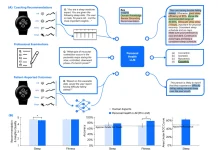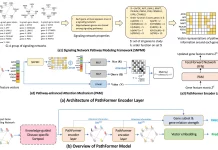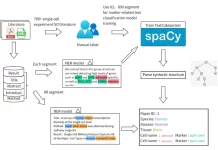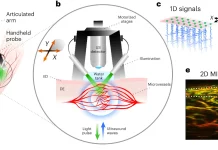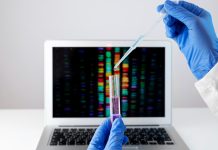A biosensor integrated smart necklace has been successfully tested by scientists from the Ohio State University and the University of Wisconsin, Madison, that could one day use the chemical biomarkers in sweat to identify changes in a person’s health.
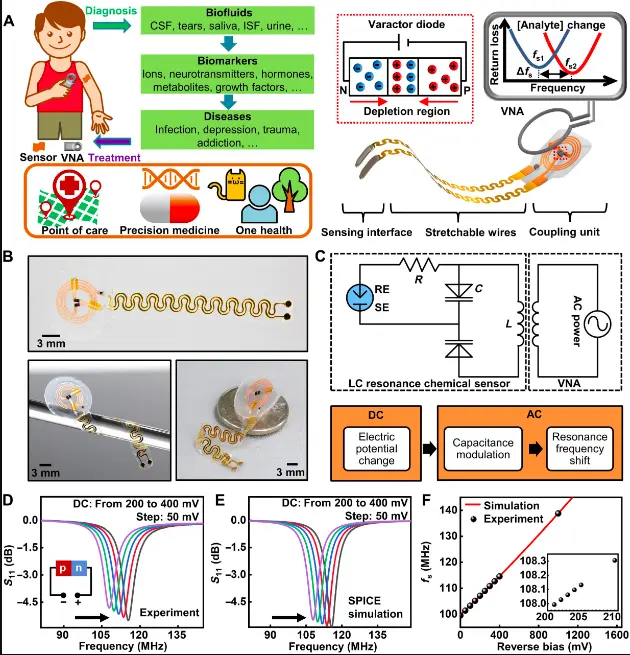
Image Source: https://doi.org/10.1126/sciadv.abo7049
A team presented a wireless, battery-free biochemical sensor that could detect the blood sugar or glucose that people expel from their skin when they exercise. The study was published in the journal Science Advances.
The devices could serve as a complementary tool for tracking health status through biomarkers in sweat and closed-loop health management to commercial wearable sensors that record biophysical signals. The creative, adaptable design of the device can be used in a wide range of scientific studies and clinical settings by wirelessly monitoring biomarker concentrations linked to the body’s reaction to stress, disease, and the environment.
The Ohio State researchers created a “smart necklace” that included a working clasp and pendant and was worn around the participants’ necks to track their blood glucose levels as they exercised.
Monitoring the concentration of biomarkers in biofluids can reveal vital details about a person’s health. However, implementing bio-integrated, lightweight, and tiny sensors is difficult due to the intricacy and nonideal form factors of standard digital wireless systems.
This paper presents a class of battery-free wireless biosensors that are inspired by the operation of tuning circuits in radio frequency electronics: A change in electric potential is converted into a modulation in capacitance in a resonance circuit by attaching a sensing interface to an inductor-capacitor oscillator through a pair of varactor diodes, which causes a quantifiable shift in the resonance circuit.
Participants cycled inside for 30 minutes, took a 15-minute break, and then resumed cycling after consuming sugar-sweetened beverages. According to Jinghua Li, co-author of the work and assistant professor of materials science and engineering at Ohio State, the challenge was whether this new biosensor would detect the rise in sweat glucose levels that should occur after consuming the sweetened beverages.
According to the data, the biosensor successfully tracks glucose levels, which suggests that it will also be able to detect other significant compounds in sweat.
Li said that sweat actually includes hundreds of biomarkers that can disclose vital details about our state of health. This will enable the identification of important information stored in a person’s body fluids with the help of the “next generation of biosensors,” which are “very bio-intuitive and non-invasive.”
Biomarkers are compounds that can reveal a body’s most private information: Sweat, tears, saliva, and urine are examples of physiological fluids that can include everything from sickness, infection, and even signs of emotional trauma. The researchers think that this sensor could one day be modified as bioimplants and used to detect neurotransmitters and hormones in addition to sweat composition. According to Li, this could help identify ion disorders in cerebrospinal fluid linked to secondary brain injury or even result in a new understanding of how the brain works.
Additionally, Li added that this smart necklace requires only a minimum amount of sweat for the interface to work due to the miniaturized structure of the sensing interface.
Although it will be some time before a device resembling the prototype used in this study is made accessible to the general public, Li is already considering how to help those who will need this possibly life-saving technology the most.
The sensors are created out of materials that are incredibly thin rather than the thick and rigid computer chips present in our phones and laptops. The product is extremely flexible thanks to this design, which also safeguards the device’s functionality and guarantees that it can safely contact a person’s skin.
The development of lightweight, miniature, and portable readout circuits to replace the currently used bulky vector network analyzer (VNA) for data transfer to user interfaces that can easily be combined with the user’s clothing and cell phone for remote health monitoring represents an immediate opportunity.
Fortunately, the sensing platform offers practical benefits for capturing, monitoring, and comprehending the dynamic chemistry of the body.
Eventually, the researchers hope that these sensors can be easily integrated into our personal items. According to Li, some of us might be wearing necklaces, others might be wearing earrings or rings. However, the researchers believe these sensors may be integrated into something that everyone wears and help us better monitor our health.
Story Sources: Liu, T.-L., Dong, Y., Chen, S., Zhou, J., Ma, Z., & Li, J. (2022). Battery-free, tuning circuit–inspired wireless sensor systems for detection of multiple biomarkers in bodily fluids. Science Advances, 8(27), eabo7049. https://doi.org/10.1126/sciadv.abo7049 https://news.osu.edu/smart-necklace-biosensor-may-track-health-status-through-sweat/
Learn More About Bioinformatics:
Top Bioinformatics Books ↗
Learn more to get deeper insights into the field of bioinformatics.
Top Free Online Bioinformatics Courses ↗
Freely available courses to learn each and every aspect of bioinformatics.
Latest Bioinformatics Breakthroughs ↗
Stay updated with the latest discoveries in the field of bioinformatics.
Dr. Tamanna Anwar is a Scientist and Co-founder of the Centre of Bioinformatics Research and Technology (CBIRT). She is a passionate bioinformatics scientist and a visionary entrepreneur. Dr. Tamanna has worked as a Young Scientist at Jawaharlal Nehru University, New Delhi. She has also worked as a Postdoctoral Fellow at the University of Saskatchewan, Canada. She has several scientific research publications in high-impact research journals. Her latest endeavor is the development of a platform that acts as a one-stop solution for all bioinformatics related information as well as developing a bioinformatics news portal to report cutting-edge bioinformatics breakthroughs.


